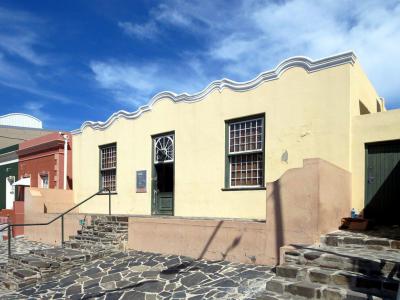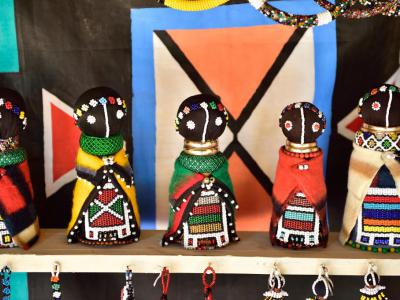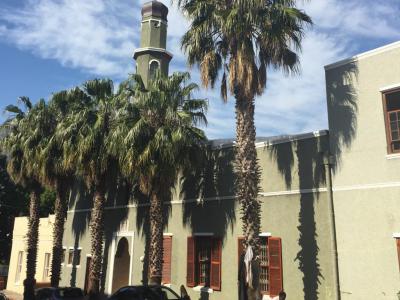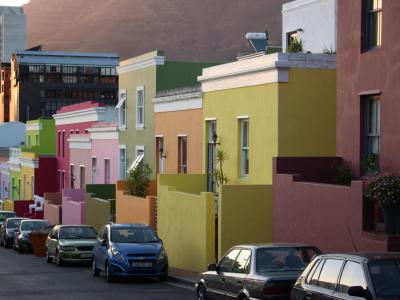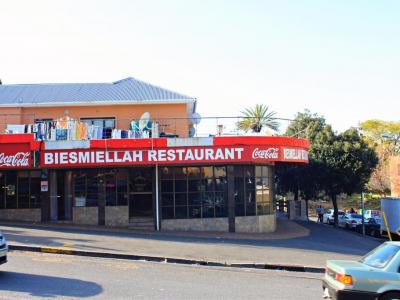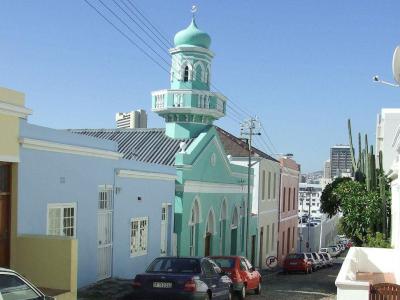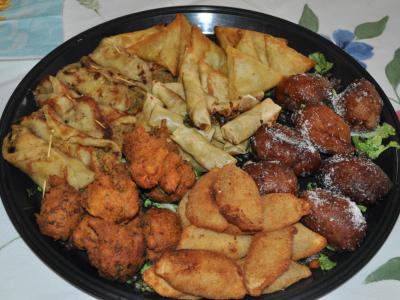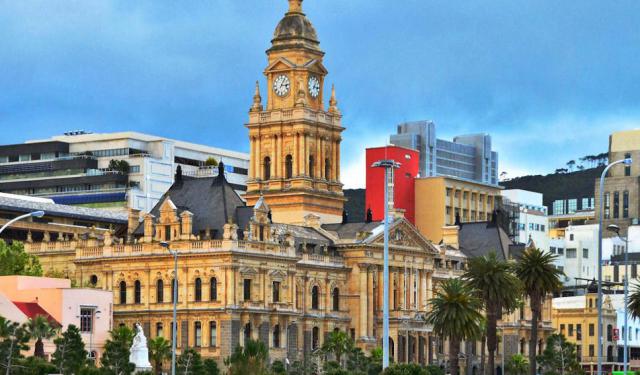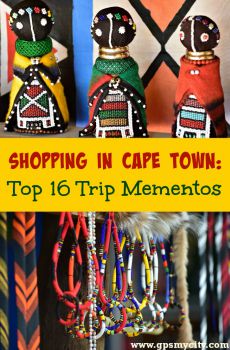Bo-Kaap Quarter Walking Tour (Self Guided), Cape Town
Bo-Kaap is Afrikaans for "above the Cape." The Bo-Kaap District is above Cape Town's city center, on the slopes of Signal Hill. It is the historical center of Cape Malay culture. In the 1760s, Jan de Waal bought land here and built houses he rented to his slaves.
Slaves came from Malaysia, Indonesia, and other parts of Africa. Many of these slaves were Muslim, and this area celebrates Islamic culture and history. Muslims continued to arrive and built Cape Dutch and Cape Georgian-style homes.
The building at 71 Wale Street was erected by de Waal in 1763 and is now the Bo-Kaap Museum. This small facility, furnished as a typical 19th-century Muslim dwelling, gives visitors an insight into a 19th-century Muslim family's daily lives.
Today, the Bo-Kaap District is treasured for its multicultural community, cobblestone streets, and distinctive architecture. You can't miss the Boorhaanol Islam Mosque, which was built in 1884 and features Cape Town's first minaret. As you stroll up Wale Street, the colorful architecture and small boutique shops are sure to catch your eye. Visitors can find unique beaded works of art at Monkeybiz, a craft store with a mission of empowering local women.
Treat yourself at Marco's African Place; it's the perfect place to enjoy a traditional African meal and some local entertainment. Take this self-guided tour for a walk down the cobblestone streets of the Bo-Kapp District and experience the unique Cape Malay culture in this beautiful part of Cape Town.
Slaves came from Malaysia, Indonesia, and other parts of Africa. Many of these slaves were Muslim, and this area celebrates Islamic culture and history. Muslims continued to arrive and built Cape Dutch and Cape Georgian-style homes.
The building at 71 Wale Street was erected by de Waal in 1763 and is now the Bo-Kaap Museum. This small facility, furnished as a typical 19th-century Muslim dwelling, gives visitors an insight into a 19th-century Muslim family's daily lives.
Today, the Bo-Kaap District is treasured for its multicultural community, cobblestone streets, and distinctive architecture. You can't miss the Boorhaanol Islam Mosque, which was built in 1884 and features Cape Town's first minaret. As you stroll up Wale Street, the colorful architecture and small boutique shops are sure to catch your eye. Visitors can find unique beaded works of art at Monkeybiz, a craft store with a mission of empowering local women.
Treat yourself at Marco's African Place; it's the perfect place to enjoy a traditional African meal and some local entertainment. Take this self-guided tour for a walk down the cobblestone streets of the Bo-Kapp District and experience the unique Cape Malay culture in this beautiful part of Cape Town.
How it works: Download the app "GPSmyCity: Walks in 1K+ Cities" from Apple App Store or Google Play Store to your mobile phone or tablet. The app turns your mobile device into a personal tour guide and its built-in GPS navigation functions guide you from one tour stop to next. The app works offline, so no data plan is needed when traveling abroad.
Bo-Kaap Quarter Walking Tour Map
Guide Name: Bo-Kaap Quarter Walking Tour
Guide Location: South Africa » Cape Town (See other walking tours in Cape Town)
Guide Type: Self-guided Walking Tour (Sightseeing)
# of Attractions: 7
Tour Duration: 1 Hour(s)
Travel Distance: 1.0 Km or 0.6 Miles
Author: DanaOffice
Sight(s) Featured in This Guide:
Guide Location: South Africa » Cape Town (See other walking tours in Cape Town)
Guide Type: Self-guided Walking Tour (Sightseeing)
# of Attractions: 7
Tour Duration: 1 Hour(s)
Travel Distance: 1.0 Km or 0.6 Miles
Author: DanaOffice
Sight(s) Featured in This Guide:
- Bo-Kaap Museum
- Monkeybiz
- Auwal Mosque
- Wale Street
- Biesmiellah Restaurant
- Boorhaanol Islam Mosque
- Marco’s African Place
1) Bo-Kaap Museum
The Bo-Kaap Museum's building dates back to the 1760s. It's the oldest unchanged house in the area. The Bo-Kapp Museum celebrates the Cape Muslims' culture, which prospered in this area after the abolition of slavery in the 1834. The museum was founded in 1978.
The museum is furnished as a typical 19th-century Muslim dwelling and celebrates Islamic culture. The "Cape Malays" were known as skilled artists, carpenters, and scholars. The old Cape Dutch feel is accentuated by yellowwood floors and ceilings. The teak door frames, window frames, and shutters are representative of the traditional local style.
One of the rooms is beautifully decorated as a bridal chamber and features a bridal dress. Visitors will also find examples of Quranic calligraphy, historic photographs, and Islamic art.
Another exhibit is dedicated to the convicts, slaves, and free workers who built Cape Town over three centuries. This exhibit focuses on pre-apartheid racial discrimination.
The museum is furnished as a typical 19th-century Muslim dwelling and celebrates Islamic culture. The "Cape Malays" were known as skilled artists, carpenters, and scholars. The old Cape Dutch feel is accentuated by yellowwood floors and ceilings. The teak door frames, window frames, and shutters are representative of the traditional local style.
One of the rooms is beautifully decorated as a bridal chamber and features a bridal dress. Visitors will also find examples of Quranic calligraphy, historic photographs, and Islamic art.
Another exhibit is dedicated to the convicts, slaves, and free workers who built Cape Town over three centuries. This exhibit focuses on pre-apartheid racial discrimination.
2) Monkeybiz
Located next door to the Bo-Kaap Museum, the Monkeybiz boutique sells unique beaded dolls and animals of all sizes. However, this is not simply a quaint toy store. It's a non-profit organization that gives work to over 320 local beaders. These local women are trained in beadwork, given materials, and then can work from home. Their work enables them to provide for their families, and working from home allows the artists to save on transport costs and childcare.
Traditional beaded necklaces and artworks are thought to impart spiritual energy. Each beaded doll is truly unique. Each artist chooses her pattern and colors. The resulting dolls and animals are genuinely treasured works of art. Monkeybiz has more than just dolls and animals. They also sell beaded fridge magnets, Christmas tree decorations, bridal cake toppers, and life-size animals.
Monkeybiz aims to be environmentally friendly, too. They use discarded cutoffs from local clothing manufacturers to create filling for the dolls and animals.
Traditional beaded necklaces and artworks are thought to impart spiritual energy. Each beaded doll is truly unique. Each artist chooses her pattern and colors. The resulting dolls and animals are genuinely treasured works of art. Monkeybiz has more than just dolls and animals. They also sell beaded fridge magnets, Christmas tree decorations, bridal cake toppers, and life-size animals.
Monkeybiz aims to be environmentally friendly, too. They use discarded cutoffs from local clothing manufacturers to create filling for the dolls and animals.
3) Auwal Mosque
The Auwal Mosque, sometimes spelled Awwal, Owal, or Owwal, is located in the Bo-Kaap area of Cape Town and is considered the oldest mosque in South Africa. Built in 1794 during the initial British presence in the Cape, it sits on land originally owned by Coridon van Ceylon, a freed Black Muslim slave. Coridon's daughter, Saartjie van de Kaap, inherited the land, which was previously used as a warehouse, and generously donated it for the construction of South Africa's inaugural mosque.
Originally erected in 1794, the mosque underwent renovations in 1907 and significant refurbishments in 1936. Notably, it was the first mosque in the region to hold public prayers and served as an early hub for Cape Muslim customs and the teaching of Arabic-Afrikaans. Its significance lies in its role as a beacon for the recognition of Islam and the freedom of worship for former slaves.
The initial imam appointed to the mosque was Qadi Abdussalam, fondly known as Tuan Guru, a prominent religious figure and former political detainee. During his imprisonment, he transcribed the entire Quran from memory, a copy of which is now showcased within the mosque. Tuan Guru also utilized the mosque as a madrassah, or religious school, where he educated both children and adults in Islamic teachings.
Following Tuan Guru's passing, Saartjie van de Kaap's husband, Achmad of Bengal, assumed the imamship. This role remained within his family until the passing of Gasan Achmat in 1980. Since then, numerous imams have succeeded, including notable figures like Sheikh Salih Abadi. Presently, Moulana Mugammad Carr and Sheikh Ismail Londt serve jointly as imams.
A disagreement over the succession of the imam led to a faction splitting from the congregation in 1807, forming Cape Town's second mosque, the Palm Tree Mosque on Long Street.
Originally erected in 1794, the mosque underwent renovations in 1907 and significant refurbishments in 1936. Notably, it was the first mosque in the region to hold public prayers and served as an early hub for Cape Muslim customs and the teaching of Arabic-Afrikaans. Its significance lies in its role as a beacon for the recognition of Islam and the freedom of worship for former slaves.
The initial imam appointed to the mosque was Qadi Abdussalam, fondly known as Tuan Guru, a prominent religious figure and former political detainee. During his imprisonment, he transcribed the entire Quran from memory, a copy of which is now showcased within the mosque. Tuan Guru also utilized the mosque as a madrassah, or religious school, where he educated both children and adults in Islamic teachings.
Following Tuan Guru's passing, Saartjie van de Kaap's husband, Achmad of Bengal, assumed the imamship. This role remained within his family until the passing of Gasan Achmat in 1980. Since then, numerous imams have succeeded, including notable figures like Sheikh Salih Abadi. Presently, Moulana Mugammad Carr and Sheikh Ismail Londt serve jointly as imams.
A disagreement over the succession of the imam led to a faction splitting from the congregation in 1807, forming Cape Town's second mosque, the Palm Tree Mosque on Long Street.
4) Wale Street
Wale Street transverses the heart of the Bo-Kaap District. Here, you will find colorful houses and traditional cobbled streets. Some of the houses date back to 1763-1768. In the 18th and 19th centuries, the Dutch captured slaves from Indonesia, Zanzibar, Mozambique, and Madagascar. These slaves leased homes in the Bo-Kaap district. According to folklore, when the houses were leased, they had to be painted white. After the slaves were granted freedom and allowed to buy houses, the former slaves painted the homes in vibrant colors.
The Bo-Kaap area is steeped in Malaysian culture. Many descendants live in the Bo-Kaap area and keep the "Cape Malay" traditions alive. Cape Minstrel Carnival is held every January 2nd and is a must-see if you are in the area.
While walking on Wale Street, keep an eye out for Islamic shrines, known as "kramats." You'll also see mosques, food markets, and craft markets in the area.
Visitors will love trying Cape Malay food; it's spicy, aromatic, and delicious!
The Bo-Kaap area is steeped in Malaysian culture. Many descendants live in the Bo-Kaap area and keep the "Cape Malay" traditions alive. Cape Minstrel Carnival is held every January 2nd and is a must-see if you are in the area.
While walking on Wale Street, keep an eye out for Islamic shrines, known as "kramats." You'll also see mosques, food markets, and craft markets in the area.
Visitors will love trying Cape Malay food; it's spicy, aromatic, and delicious!
5) Biesmiellah Restaurant
Biesmiellah Restaurant serves traditional Cape Malay food. Both indoor and rooftop seating is available. Visitors that choose the rooftop are treated to views of Bo-Kaap and Table Mountain. Diners should note that alcohol is not served at this traditional Muslim restaurant and is not permitted on the premises.
The restaurant looks unassuming from the outside. Inside, it's very welcoming. Islamic art hangs on the walls, and wood paneling adds to the cozy decor.
The food is quite spicy. Bobotie is one of the most popular menu items. Bobotie is made with beef, curry spices, raisins, and an egg topping. The flavors are intoxicating and very unique. The Pienang curry is a delicious Cape Malay sweet and sour curry. Denningvleis is another unique Cape Malay dish that is sure to delight.
Biesmiellah also serves Indian curries like Butter Chicken. Samoosas, chili bites, and koeksisters are also popular dishes. Mango lassi is a deliciously cool and refreshing drink to balance out the spicy meals.
The restaurant looks unassuming from the outside. Inside, it's very welcoming. Islamic art hangs on the walls, and wood paneling adds to the cozy decor.
The food is quite spicy. Bobotie is one of the most popular menu items. Bobotie is made with beef, curry spices, raisins, and an egg topping. The flavors are intoxicating and very unique. The Pienang curry is a delicious Cape Malay sweet and sour curry. Denningvleis is another unique Cape Malay dish that is sure to delight.
Biesmiellah also serves Indian curries like Butter Chicken. Samoosas, chili bites, and koeksisters are also popular dishes. Mango lassi is a deliciously cool and refreshing drink to balance out the spicy meals.
6) Boorhaanol Islam Mosque
The Boorhaanol Islam Mosque was built in 1884. It was originally known as Pilgrim Mosque and featured the first minaret in Cape Town. The minaret features a tower with a balcony. The balcony is used to call the faithful to prayer five times a day. The tall, distinctive minaret also serves as a visual reminder to the Muslim community.
The Boorhaanol Islam Mosque's original minaret was made from wood and blew down in a storm in the 1930s. The current minaret is made from concrete.
Boorhaanol Islam Mosque is the only mosque in Cape Town that has been declared a National Monument. In keeping with the rest of the Bo-Kaap district, it is painted in bright seafoam green with eye-catching white trim.
The Dutch and British occupiers were often hostile to the practice of the Muslim faith. Throughout much of the 20th century, the Muslim community was burdened by racist attitudes and laws. Since 1994, all religions are permitted to practice freely.
Besides providing a spiritual center to the Cape Malay Muslim community, the Boorhaanol Islam Mosque provides community services and programs.
The Boorhaanol Islam Mosque's original minaret was made from wood and blew down in a storm in the 1930s. The current minaret is made from concrete.
Boorhaanol Islam Mosque is the only mosque in Cape Town that has been declared a National Monument. In keeping with the rest of the Bo-Kaap district, it is painted in bright seafoam green with eye-catching white trim.
The Dutch and British occupiers were often hostile to the practice of the Muslim faith. Throughout much of the 20th century, the Muslim community was burdened by racist attitudes and laws. Since 1994, all religions are permitted to practice freely.
Besides providing a spiritual center to the Cape Malay Muslim community, the Boorhaanol Islam Mosque provides community services and programs.
7) Marco’s African Place
Visitors arriving at Marco's African Place are immersed in African culture, food, and music. Marco's African Place features both traditional African food and multicultural Cape cuisine.
The proprietor and chef, Marco, was the first black restauranter in Cape Town. He opened his first restaurant in 1989. Marco's African Place opened in 1997.
Here, you can have unique African dishes you can't get anywhere else. Crocodile and impala are popular choices. Diners can also try traditional Xhosa Dishes. For a tour of African specialties, try the Pan African Platter with Springbok, Kudu, and Ostrich.
To complete the exquisite meal, pair with a home-brewed African beer. Marco's also offers a full bar with an extensive wine, liquor, and cocktail menu.
Nightly live entertainment includes local bands, singers, and dancers. With the immersive atmosphere and so many delightful food choices, visitors often find themselves spending the entire evening at Marco's African Place.
Save room for a dessert; a delightful selection of sweet temptations is offered.
The proprietor and chef, Marco, was the first black restauranter in Cape Town. He opened his first restaurant in 1989. Marco's African Place opened in 1997.
Here, you can have unique African dishes you can't get anywhere else. Crocodile and impala are popular choices. Diners can also try traditional Xhosa Dishes. For a tour of African specialties, try the Pan African Platter with Springbok, Kudu, and Ostrich.
To complete the exquisite meal, pair with a home-brewed African beer. Marco's also offers a full bar with an extensive wine, liquor, and cocktail menu.
Nightly live entertainment includes local bands, singers, and dancers. With the immersive atmosphere and so many delightful food choices, visitors often find themselves spending the entire evening at Marco's African Place.
Save room for a dessert; a delightful selection of sweet temptations is offered.
Walking Tours in Cape Town, South Africa
Create Your Own Walk in Cape Town
Creating your own self-guided walk in Cape Town is easy and fun. Choose the city attractions that you want to see and a walk route map will be created just for you. You can even set your hotel as the start point of the walk.
Historical Houses Walking Tour
When Jan van Riebeeck arrived in Cape Town in 1652, his mission was to establish here a supply station for the ships of the Dutch East India Company sailing to East Africa, India, and the Far East. The oldest buildings in today's Cape Town, dating from the second half of the 17th century, are the remnants of that era.
Garden House, originally a shabby tool shed owned by the Dutch East... view more
Tour Duration: 1 Hour(s)
Travel Distance: 2.8 Km or 1.7 Miles
Garden House, originally a shabby tool shed owned by the Dutch East... view more
Tour Duration: 1 Hour(s)
Travel Distance: 2.8 Km or 1.7 Miles
Cape Town Shopping Tour
Cape Town is grand with quality shopping. The available options here, such as South Africa's top flea market where you can find a wealth of merchandise, from tribal costumes to precious jewelry, offer a colorful experience for both locals and tourists.
Among the standout locations in Cape Town that shoppers particularly love to explore is Adderley Street. This bustling thoroughfare is... view more
Tour Duration: 1 Hour(s)
Travel Distance: 0.4 Km or 0.2 Miles
Among the standout locations in Cape Town that shoppers particularly love to explore is Adderley Street. This bustling thoroughfare is... view more
Tour Duration: 1 Hour(s)
Travel Distance: 0.4 Km or 0.2 Miles
Cape Town Introduction Walking Tour
Portuguese explorer Bartolomeu Dias first mentioned the Cape of Storms in 1488, but it was soon renamed the Cape of Good Hope with an optimistic eye towards the trade routes it offered between Europe and the East.
In 1652, the Dutch East India Company settled a way-station here for ships traveling that route. Cape Town's natural harbor and strategic position made it the perfect location.... view more
Tour Duration: 1 Hour(s)
Travel Distance: 2.1 Km or 1.3 Miles
In 1652, the Dutch East India Company settled a way-station here for ships traveling that route. Cape Town's natural harbor and strategic position made it the perfect location.... view more
Tour Duration: 1 Hour(s)
Travel Distance: 2.1 Km or 1.3 Miles
Useful Travel Guides for Planning Your Trip
16 Distinctively South African Things to Buy in Cape Town
The many hopes pinned on this place (Cape of Good Hope) by passing-by sailors over the centuries must have done a good job for Cape Town, seeing it become a colorful cultural hub and prominent metropolis (3rd largest) in South Africa. Overlooking the meeting point of the two oceans (Indian and...
The Most Popular Cities
/ view all



